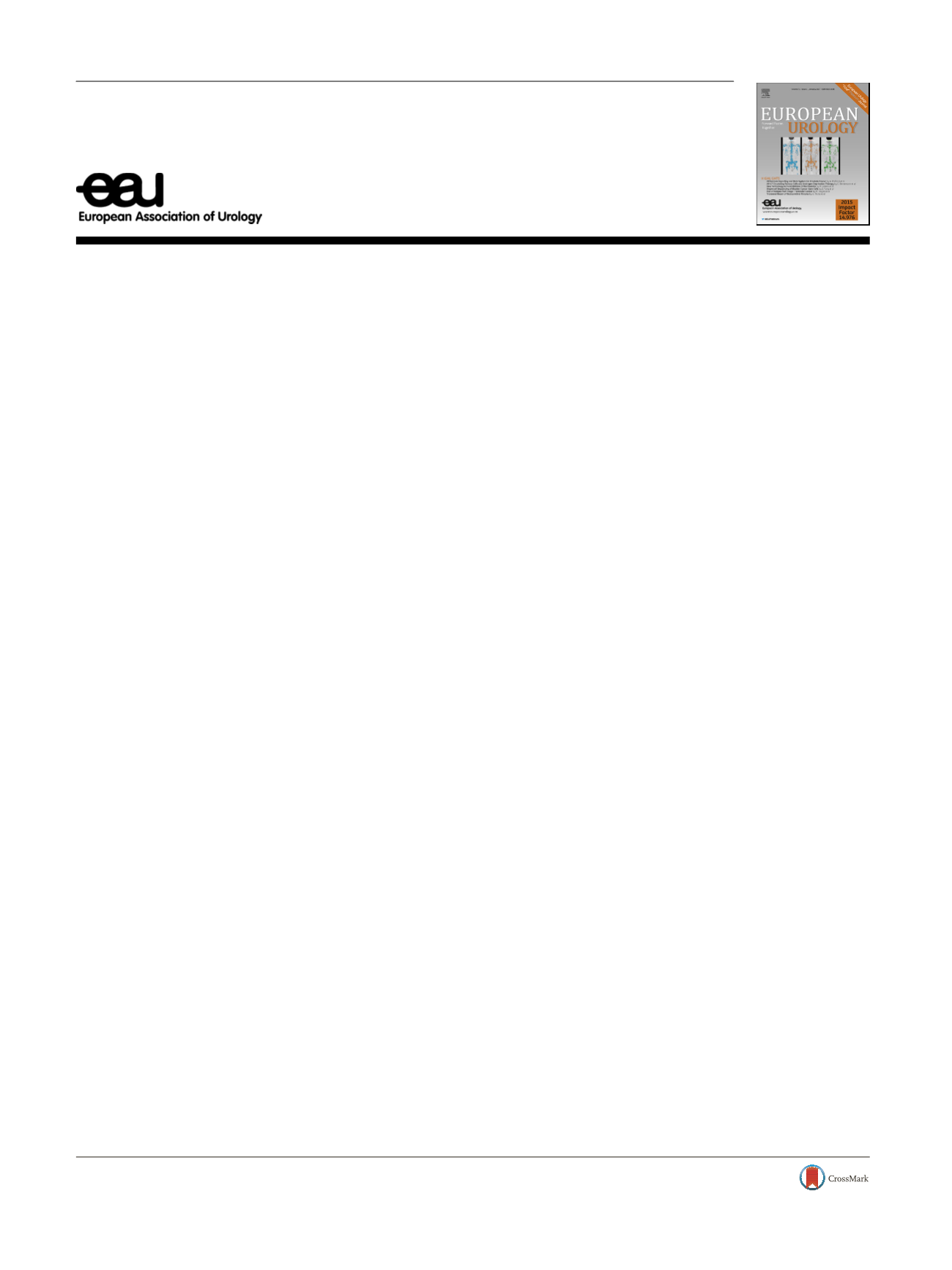

Platinum Priority – Editorial
Referring to the article published on pp. 952–959 of this issue
Comprehensive Molecular Characterization of Urothelial Bladder
Carcinoma: A Step Closer to Clinical Translation?
Cyrill A. Rentsch
a[1_TD$DIFF]
, * ,David C. Mu¨ller
a[2_TD$DIFF]
, b ,Christian Ruiz
b[3_TD$DIFF]
,Lukas Bubendorf
b[4_TD$DIFF]
a
Department of Urology, University Hospital Basel, University of Basel, Switzerland;
b
Institute of Pathology, University Hospital Basel, University of Basel,
Basel, Switzerland
In 2014, The Cancer Genome Atlas (TCGA) Research
Network published a comprehensive molecular characteri-
zation of muscle-invasive bladder carcinoma (MIBC)
[1] .In
this issue of
European Urology
and more than 3 yr later,
Pietzak et al
[2]describe next-generation sequencing (NGS)
of 341-410 cancer-associated genes in a cohort of more than
100 patients with non–muscle-invasive bladder cancer
(NMIBC). Although limited by the number of genes
analysed, this study provides a profound insight into the
mutational landscape of NMIBC and represents, to the best
of our knowledge, the study with the largest cohort of
NMIBC assessed via targeted NGS. By contrast, the TCGA
analysis on MIBC covered the whole exome and also
analysed gene expression, which allowed identification of
distinct basal and luminal types of urothelial carcinoma
[1,3]. While we assume that Pietzak et al are currently
working on gene expression analysis in their valuable
cohort, the question remains whether an extension to
whole-exome sequencing or even whole-genome sequenc-
ing could provide us with more clinically relevant insights.
The DNA methylation profile is another treasure that might
provide important pieces to complete the puzzle for NMIBC.
The catalogue of mutations found by the authors includes
several potential diagnostic, prognostic, and predictive
biomarkers in NMIBC, many of which have previously been
studied in bladder cancer, such as
pTERT
,
FGFR3
, and DNA
damage response genes. From experience, however, it is a
long and strenuous path from the discovery of a promising
bladder cancer marker through prospective studies to new
practice guidelines. The majority of all proposed biomarkers
in bladder cancer have not survived this ‘‘valley of death’’ in
the past. It is hoped that the power of mutational panel
testing combined with other technologies will ultimately
change this slow pace of progress.
An important limitation in studies with NMIBC is the
restricted availability of sufficient tissue for DNA and RNA
extraction, as well as the heterogeneity and multifocality of
the disease. Therefore, the authors have to be congratulated
for their achievement in performing targeted NGS on tissue
from 12 patients with carcinoma in situ (CIS). For further
studies it will be important to develop methods to separate
CIS from papillary cancer tissue and to analyse the fractions
separately to obtain a better picture on the performance of a
given biomarker. Nevertheless, an interesting observation of
this study is the association of
ARID1A
mutations with poorer
response among patients treated with bacillus Calmette-
Gue´ rin (BCG) induction without BCGmaintenance. Tumours
with
ARID1A
mutation were three times more likely to recur.
In total, 30 patients with CIS, whether isolated or concomi-
tant, were included in the study.
ARID1A
mutations were
detected in approximately half of them. Whether the
ARID1A
mutation rate correlates with the expected BCG failure rate
in these high-risk patients will need careful validation
pertaining not only to recurrence but also to progression to
muscle-invasive disease, BCG maintenance therapy, and, as
mentioned above, cancer heterogeneity. Given the strong
correlation previously demonstrated between
ARID1A
muta-
tions and lost expression of the encoded protein, immuno-
histochemistry appears to be a suitable method for
addressing these questions in a sufficiently high number
of patients, especially for CIS lesions, for which enrichment
of tumour cells for DNA analysis remains challenging
[4].
E U R O P E A N U R O L O G Y 7 2 ( 2 0 1 7 ) 9 6 0 – 9 6 1available at
www.scienced irect.comjournal homepage:
www.europeanurology.comDOI of original article:
http://dx.doi.org/10.1016/j.eururo.2017.05.032.
* Corresponding author. Institute of Pathology, University Hospital Basel, University of Basel, Spitalstrasse 21, Basel 4031, Switzerland.
Tel. +41 61 2652525.
E-mail address:
crentsch@uhbs.ch(C.A. Rentsch).
http://dx.doi.org/10.1016/j.eururo.2017.06.0220302-2838/
#
2017 European Association of Urology. Published by Elsevier B.V. All rights reserved.
















